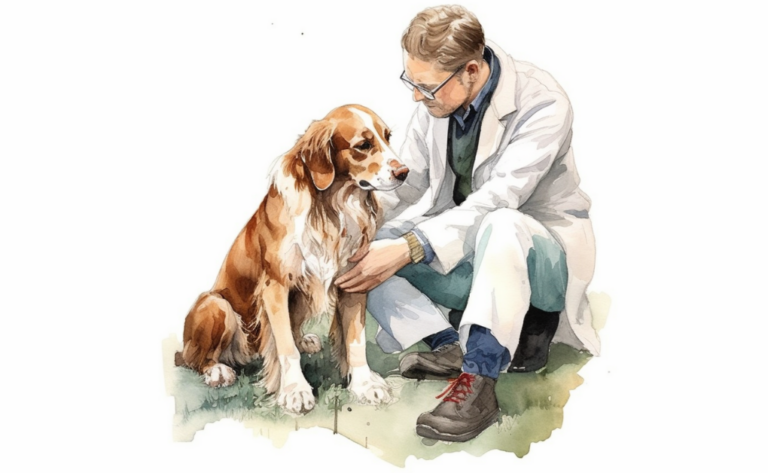What is a Gastrointestinal Parasite in Dogs?
What is it?
How is it Treated?
Breed Predispositions
Beagles Coonhounds Foxhounds German Shepherds Boxers Doberman Pinschers
Introduction
Olivia had been noticing that her beloved Australian Shepherd, Jasper, was experiencing some unusual digestive issues lately. He had been losing weight, had intermittent diarrhea, and seemed to have a decrease in energy. Concerned for Jasper’s well-being, Olivia promptly scheduled an appointment with her veterinarian. After a thorough examination and some lab tests, the vet informed Olivia that Jasper was suffering from a gastrointestinal parasite infection, something she had never considered as a possibility. In this blog post, we’ll take a closer look at gastrointestinal parasites in dogs.
Gastrointestinal parasites, also known as dog parasites, constitute a variety of organisms that inhabit the digestive system of domestic dogs. This group of parasites can encompass different types of worms, including roundworms, hookworms, whipworms, and tapeworms, along with protozoans such as Giardia and Coccidia. Often, these parasites are ingested when dogs consume food, water, or feces contaminated with microscopic eggs.
These parasites can disrupt the digestive tract’s normal operations, leading to various health complications. For example, they can trigger inflammation and damage the intestinal lining, and parasites can interfere with nutrient absorption, provoking diarrhea and other gastrointestinal symptoms. In addition, in more serious instances of infestation, these zoonotic parasites can induce weight loss, stunted growth, anemia, and overall compromised health.
Types of Intestinal Parasites in Dogs
Several types of gastrointestinal parasites can infect dogs. These include:
Roundworms
Roundworms, or Toxocara canis, are one of the most common intestinal parasites in dogs. They can be transmitted to puppies through the mother’s milk or ingesting contaminated soil or feces. Roundworms can cause digestive disturbances, poor growth, dull coat, potbelly appearance, and even blockage of the intestines in severe cases.
Hookworms
Hookworms, such as Ancylostoma caninum, attach to the intestinal lining and feed on blood. They can be acquired through ingestion, skin contact, or larvae penetration. Hookworm infestations can lead to anemia, bloody or dark stools, weight loss, weakness, and poor overall condition.
Whipworms
Whipworms (Trichuris vulpis) primarily affect the large intestine of dogs. Infections occur through the ingestion of whipworm eggs from contaminated soil or objects. Symptoms of whipworm infestation include chronic diarrhea, weight loss, anemia, and inflammation of the large intestine.
Tapeworms
Tapeworms, such as Dipylidium caninum, are transmitted to dogs by ingesting fleas or infected intermediate hosts, such as rodents. Tapeworms typically cause mild symptoms, including irritation around the anus, scooting, and small white segments resembling rice grains in the feces.
Giardia
Giardia is a protozoan parasite that can affect the small intestine of dogs. It is often transmitted through contaminated water sources. Infected dogs may experience diarrhea, vomiting, weight loss, and poor appetite.
Coccidia
Coccidia is another type of protozoan parasite that can cause gastrointestinal problems in dogs. They are typically ingested by eating contaminated feces or soil. Infection with coccidia can lead to diarrhea, dehydration, weight loss, and general weakness.
Each type of intestinal parasite can affect the dog’s health differently, but common symptoms include gastrointestinal disturbances, diarrhea, weight loss, poor growth, and overall malaise. Working with a veterinarian is essential to diagnose and treat intestinal parasite infestations in dogs accurately.
Causes of Intestinal Parasite in Dogs
Dogs may contract intestinal parasites, also known as common intestinal parasites, through various methods, often depending on the specific type of parasite. Here are the key ways dogs can be exposed:
- Ingestion: Dogs can become infected by consuming worm eggs, larvae, or cysts in contaminated soil, water, or feces. This usually occurs when dogs lick or sniff contaminated surfaces, eat food or drink water that’s contaminated, or interact with infected animals. Parasite eggs can be easily ingested in these ways, whether from common tapeworms such as Dipylidium caninum or T. vulpis.
- Infestations of external parasites: Certain parasites, like tapeworms, are passed to dogs by ingesting infected external parasites like fleas or ticks. When dogs groom themselves and inadvertently ingest these fleas or ticks, they may consume tapeworm larvae within the infected flea, leading to tapeworm infection.
- Exposure to contaminated environments: Dogs that frequent environments rife with parasites, such as dog parks, kennels, or locales with substandard sanitation, have an increased risk of acquiring intestinal parasites. These surroundings may harbor a high concentration of worm eggs or larvae, thus elevating the chances of dogs encountering them.
- Maternal transmission: If their mother is infected, puppies can be born with intestinal parasites. Parasite larvae can be transmitted to the puppies through the placenta or during nursing, causing an early infestation.
- Intermediary hosts: Some parasites, including many of these parasites such as common tapeworms, necessitate an intermediary host, like fleas or small mammals, to fulfill their life cycle. Therefore, if dogs ingest these hosts, they may contract the parasite, leading to a potential Giardia or hookworm infection.
Bear in mind that each parasite possesses specific transmission modes and life cycles. As such, preventative strategies, including regular deworming, maintaining good hygiene, and minimizing exposure to environments contaminated with parasites, can help diminish the risk of dogs contracting intestinal parasites.
Symptoms of Intestinal Parasites in Dogs
Different parasites or common intestinal parasites can induce various symptoms in dogs. Here are the frequent symptoms tied to specific intestinal parasites:
Roundworms, namely Toxocara canis and Toxascaris leonina, can lead to:
- Vomiting
- Diarrhea
- Pot-bellied appearance
- Lackluster coat
- Coughing (if larvae migrate to the lungs)
- Visible worm eggs or even entire worms in feces or vomit

Hookworms, specifically Ancylostoma caninum and Uncinaria stenocephala, can result in:
- Anemia (evident through pale gums, weakness, fatigue)
- Bloody or dark, tarry stools (melena)
- Hindered growth in puppies, leading to hookworm infection
- Weight loss
- Reduced appetite
- Diarrhea
Whipworms (Trichuris vulpis) might cause:
- Diarrhea, potentially containing mucus or blood
- Weight loss
- Dehydration
- Anemia (in severe cases)
- Lethargy
Tapeworms, such as Dipylidium caninum and Taenia spp., also a common tapeworm, can induce:
- Visible segments of the tapeworm egg (resembling grains of rice) in feces or around the anus, pointing to an infected flea
- Anal itching or scooting
- Weight loss
- Poor coat condition
- Occasional abdominal discomfort
Giardia, particularly Giardia duodenalis, may trigger a Giardia infection, with symptoms including:
- Diarrhea (frequently foul-smelling and greasy)
- Weight loss
- Poor appetite
- Vomiting (less common)
- Dehydration
- Flatulence
However, it’s crucial to understand that these symptoms do not definitively indicate the presence of a particular parasite. A proper diagnosis necessitates fecal testing or other diagnostic methods to identify the specific parasite and devise an appropriate treatment plan. Also, some dogs infested with intestinal parasites might display little to no symptoms, especially during mild infestations. This emphasizes the importance of regular preventive measures like deworming and fecal testing, particularly for dogs frequenting environments such as dog parks where many parasites are common, to uphold their overall health.
Diagnosis of Canine Gastrointestinal Parasites
Diagnosing gastrointestinal parasites in dogs typically involves several steps and may rely on different diagnostic tests:
Fecal Exam (Fecal Flotation Test)
“The fecal flotation test is a fundamental method employed by the American Veterinary Medical Association for diagnosing gastrointestinal parasites in adult dogs and puppies alike. The process entails collecting a minor sample of the pet’s stool and merging it with a special solution. This solution is denser than the parasite eggs in the feces, thus making the eggs float to the surface. After a set duration, a cover slide placed atop the solution is removed and inspected under a microscope. This procedure enables the veterinarian to recognize parasite eggs indicative of particular worms or other intestinal parasites, providing a vital, non-invasive diagnosis of any parasitic infestation that a dog may have.
Fecal Smear
The fecal smear test represents another approach used for diagnosing gastrointestinal parasites in dogs. Despite bearing similarities to the fecal flotation test, it follows different procedures. The fecal smear test involves thinly spreading a small number of fresh feces onto a microscope slide, inspected under a microscope. In a fecal flotation test, this method identifies parasites and their eggs that may not float. Certain parasites, such as Giardia or coccidia, are more likely to be detected this way. Though this test may be less sensitive than a flotation test, it’s valuable for spotting certain parasites that may go unnoticed.
Blood Tests
Blood tests can aid in diagnosing gastrointestinal parasites in dogs, offering a comprehensive outlook on the pet’s overall health. In addition, these tests are the principal diagnostic tool for specific parasites like heartworms. A complete blood count (CBC) can spot anemia, inflammation, infection, and potential indications of parasitic infestation. In addition, a dog with parasites may display elevated levels of specific proteins, suggesting an infection. However, a blood test alone typically can’t pinpoint the exact type of gastrointestinal parasite. Thus, it’s often used with other diagnostic methods, like fecal examinations.
Endoscopy or Colonoscopy
Endoscopy or colonoscopy are diagnostic techniques veterinarians can employ to visualize the gastrointestinal tract and detect signs of intestinal parasites in dogs. These procedures involve inserting a flexible tube with a camera attached through the dog’s mouth or rectum and guiding it through the digestive system.
These methods provide a direct view of the gastrointestinal tract, allowing veterinarians to spot the presence of adult worms, larvae, or eggs of intestinal parasites. This approach is particularly effective for diagnosing specific parasites that might evade detection through other diagnostic tests, such as hookworms or whipworms.
These procedures are usually conducted under sedation or anesthesia to maximize the dog’s comfort and minimize potential discomfort. The gathered samples or biopsies can be further scrutinized under a microscope or sent to a lab to determine the presence of specific parasites and steer suitable treatment.
Ultrasound or X-ray
Ultrasound and X-ray imaging are diagnostic tools veterinarians utilize to aid in diagnosing intestinal parasites in dogs. Ultrasound employs sound waves to generate real-time images of the internal organs, including the gastrointestinal tract, facilitating the visualization of abnormalities like masses or enlarged organs. X-ray imaging uses low radiation levels to produce detailed images of the internal structures, which can aid in identifying characteristic patterns or shapes linked to certain parasites like hookworms or whipworms. While these imaging techniques can yield valuable information, they may only definitively diagnose some intestinal parasites. Additional tests, such as a fecal examination or endoscopy, may be required for a more precise diagnosis.
Baermann Test
The Baermann Test is a diagnostic procedure veterinarians employ to detect certain parasites, particularly those in dogs’ respiratory or gastrointestinal tracts. It involves collecting a fresh stool sample from the dog and placing it in a unique device that extracts parasite larvae. Over several hours, the larvae migrate out of the stool and into the water, then collected and examined under a microscope. This test is particularly useful when other methods, like fecal examination, may not detect certain parasites.
Bear in mind the strategy for diagnosing parasites typically hinges on the specific symptoms the dog presents, along with its lifestyle, age, and overall health status. This highlights the prevalence of intestinal parasites collected from dogs and that parasites can cause serious health issues.
Treatment Canine Gastrointestinal Parasites
Treatment choices for intestinal parasite infections in dogs fluctuate based on the specific parasite. However, several common treatment approaches are outlined below:

Deworming Medications
These are specifically created to target and eradicate intestinal parasites in dogs. Administered as tablets, liquids, or chewable, these deworming medications exterminate the parasites or halt their life cycle, curtailing further reproduction and infestation.
The specific mechanism of these deworming medications may differ depending on the type of parasite targeted. For instance, some drugs act by paralyzing the parasites, while others obstruct their ability to absorb nutrients, culminating in their death.
Generally, deworming medications are broad-spectrum, proving effective against common intestinal parasites such as roundworms, hookworms, whipworms, and tapeworms. However, not all deworming medications are efficacious against all parasites, making it critical to use the appropriate medication based on the identified or suspected parasite.
Prescription Medications
Typically more potent and targeted than over-the-counter dewormers, these are designed to safely and effectively eliminate the specific parasite causing the infestation. Some prescription medications may require multiple doses or a treatment course to ensure total eradication of the parasites.
Following the veterinarian’s instructions for dosage, administration, and duration of treatment when using prescription medications for intestinal parasites is crucial. In addition, regular follow-up visits to the animal hospital may be necessary to track the treatment progress and assess the dog’s response to the medication.
Prescription medications offer a more targeted and tailored approach to treating intestinal parasites in dogs, ensuring effective parasite elimination and minimizing the risk of re-infestation. Consequently, they play a vital role in a comprehensive veterinarian-prescribed parasite control program.
Topical Treatments
Topical medications for treating intestinal parasites in dogs are typically applied directly to the skin, usually at the back of the neck or between the shoulder blades. These medications are formulated to be absorbed through the skin and distributed throughout the dog’s body, targeting internal parasites.
Examples of these topical medications for intestinal parasites in dogs include spot-on treatments and collars.
- Spot-on treatments are liquid formulations applied to a specific skin area. They contain active ingredients that are gradually released and absorbed into the bloodstream to kill parasites.
- Conversely, collars around the dog’s neck emit active ingredients providing continuous protection against parasites.
These topical medications exterminate the parasites on contact or inhibit their growth and reproduction. They can target a wide range of intestinal parasites, including fleas, ticks, and some types of worms. These medications offer an efficient way to prevent and treat infestations, providing pet owners with a convenient, easy-to-administer option.
Environmental Control
Environmental control refers to various measures taken to manage and minimize the presence of intestinal parasites in the dog’s living environment. While it is primarily aimed at preventing reinfestation and reducing the risk of exposure to parasites, it can also be a part of the comprehensive treatment plan for intestinal parasites in dogs.
Examples of environmental control measures include:
- Cleaning and sanitation: Regular cleaning of the dog’s living area, including bedding, toys, and surrounding areas, can help remove parasite eggs and larvae. Vacuuming carpets, mopping floors, and disinfecting surfaces can help eliminate parasites and reduce their environmental presence.
- Waste management: Proper disposal of dog feces is crucial to prevent the spread of parasites. Regularly remove and properly dispose of feces from the yard, and promptly clean up after your dog during walks or outdoor activities.
- Outdoor control: Minimize the dog’s exposure to areas with a high risk of parasite infestation, such as heavily contaminated soil or areas frequented by other animals. Avoid letting the dog roam freely in areas where parasites are known to be prevalent.
- Pest control: Implement measures to control fleas, ticks, and other external parasites that can transmit intestinal parasites. This may include regular flea and tick preventives on the dog and treating the dog’s living environment with appropriate pest control products.
Preventive Measures
Managing intestinal parasites revolves around effective prevention. Regular administration of preventive medications, such as monthly heartworm preventives that target intestinal parasites, as a veterinarian suggests, can safeguard dogs from infestations.
Here are some important preventive actions:
- Routine deworming: Regular administration of preventive deworming medications as a part of the diet recommended by your veterinarian aids in eliminating any existing parasites and halting new infestations.
- Maintaining high standards of cleanliness: Upholding good hygiene by timely and appropriately disposing of your pet’s stool aids in curbing the spread of parasite eggs in the environment. Regular cleansing and sanitizing of your dog’s living spaces, including bedding and toys, are crucial.
- Limiting contact with contaminated environments: Restrict your dog’s exposure to areas with a high likelihood of parasite infestation, such as locales frequently visited by other animals or known to harbor parasites.
- Flea and tick control: Employ suitable flea and tick preventives to shield your dog from external parasites that can transmit intestinal parasites.
- Routine veterinary examinations: Arrange regular visits to the veterinarian to check your dog’s overall health and discuss preventive measures suited to your dog’s lifestyle and risk factors. Early detection and careful handling of any issue can make a significant difference.
- Consistent grooming: Frequently groom your dog to look for signs of parasites, such as fleas, ticks, or visible worms in the intestinal tract. Remove any parasites you find promptly and consult your veterinarian for the correct treatment course if your pet is infected.
- Avoid feeding raw or undercooked meat: Raw or undercooked meat may harbor parasite larvae or eggs. Therefore, ensure your dog’s diet comprises properly cooked and safe food.
By incorporating these preventative measures, you can drastically reduce the risk of intestinal parasite infestations in your dog and uphold its overall health. Regular dialogue with your veterinarian is vital to formulate a prevention plan tailored to your dog’s requirements and lifestyle.
Frequently Asked Questions
Disclaimer: The information provided on this veterinary website is intended for general educational purposes only and should not be considered as a substitute for professional veterinary advice, diagnosis, or treatment. Always consult a licensed veterinarian for any concerns or questions regarding the health and well-being of your pet. This website does not claim to cover every possible situation or provide exhaustive knowledge on the subjects presented. The owners and contributors of this website are not responsible for any harm or loss that may result from the use or misuse of the information provided herein.







